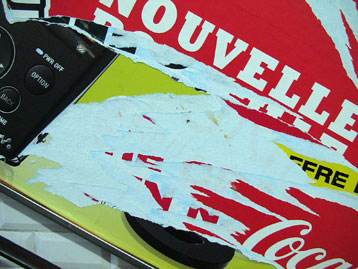| Posted: May 7, 2008 |
The 'wall paper mystery' explained by physicists |
|
(Nanowerk News) When you try to remove adhesive paper from a surface, you inevitably get a pointy flap, while what you want is to remove the entire piece. A team from the Laboratoire de physique et mécanique des milieux hétérogènes (CNRS/ESPCI/Universités Paris 6 and 7), collaborating with the University of Santiago in Chile and with MIT, has explained the physics behind this frustrating experience. The work is published in an article in the May issue of Nature Materials, and could be used in testing the mechanical properties of very fine adhesive film used in industry.
|
|
(We also reported in our Nanowerk Spotlight "The art of peeling tomatoes and the science of tearing" on this work.)
|
|
We’ve all been faced with the famous pointy flap tear: the piece being detached gets thinner and thinner as it is being pulled off, and ends up as a pointy flap instead of coming off as a whole piece of tape, wallpaper, film, fruit peel... What causes the pointy shape? Why do the two edges seem to attract each other? What determines the shape of the flaps?
|
|
With his Chilean and American colleagues, Benoît Roman, from the Laboratoire de physique et mécanique des milieux hétérogènes (CNRS/ESPCI/Universités Paris 6 and 7), has studied the problem from a theoretical and experimental point of view. The researchers have set up a system for controlled tear experiments: an adhesive film is glued to a surface, two slits are cut, and the system then provides a steady pull on the tab. The researchers then record the shapes of the flaps and the mechanical forces involved, for films with different adhesive and mechanical properties.
|
|
When the tab is pulled, after the two slits are cut, the flap stores elastic energy (if let go, it will unfold). The system tends to dissipate this energy by minimizing the size of the fold. The slits are naturally drawn to the areas of the system which are the most sollicited, namely those containing the greatest amount of elastic energy. In this case, that would be the folded part of the tab. They are irrepressibly drawn to each other, gradually reducing the size of the tab.
|
|
By analyzing these observations, the physicists have shown that the shape of the flaps is a triangle, with an angle depending on three characteristics of the adhesive material: its adhesion, its flexibility, and its resistance to tearing. The researchers have put together a formula which allows the characterization of one of these properties based on the other two and on a simple measurement of the angle of the triangle.
|
|
Materials engineers could use these results in industry to calculate one of the three properties when the other two are known. This could be particularly useful for the characterization of ultra-thin films, which are difficult to manipulate and which are basic elements in micro- or nano-systems. These are already present in our daily life (such as shock detectors for the release of airbags, micromirrors used in second generation video projectors), and they will certainly have an important role to play in our future.
|
 |
| The pointy tears observed in daily life: posters torn down in the metro
|
|
The regularity of tears is used by artist Jacques Villeglé who has been collecting, since 1948, posters torn by passersby, “anonymous lacerates”,and is putting together a retrospective at the Centre Pompidou next September (http://villegle.free.fr/).
|

